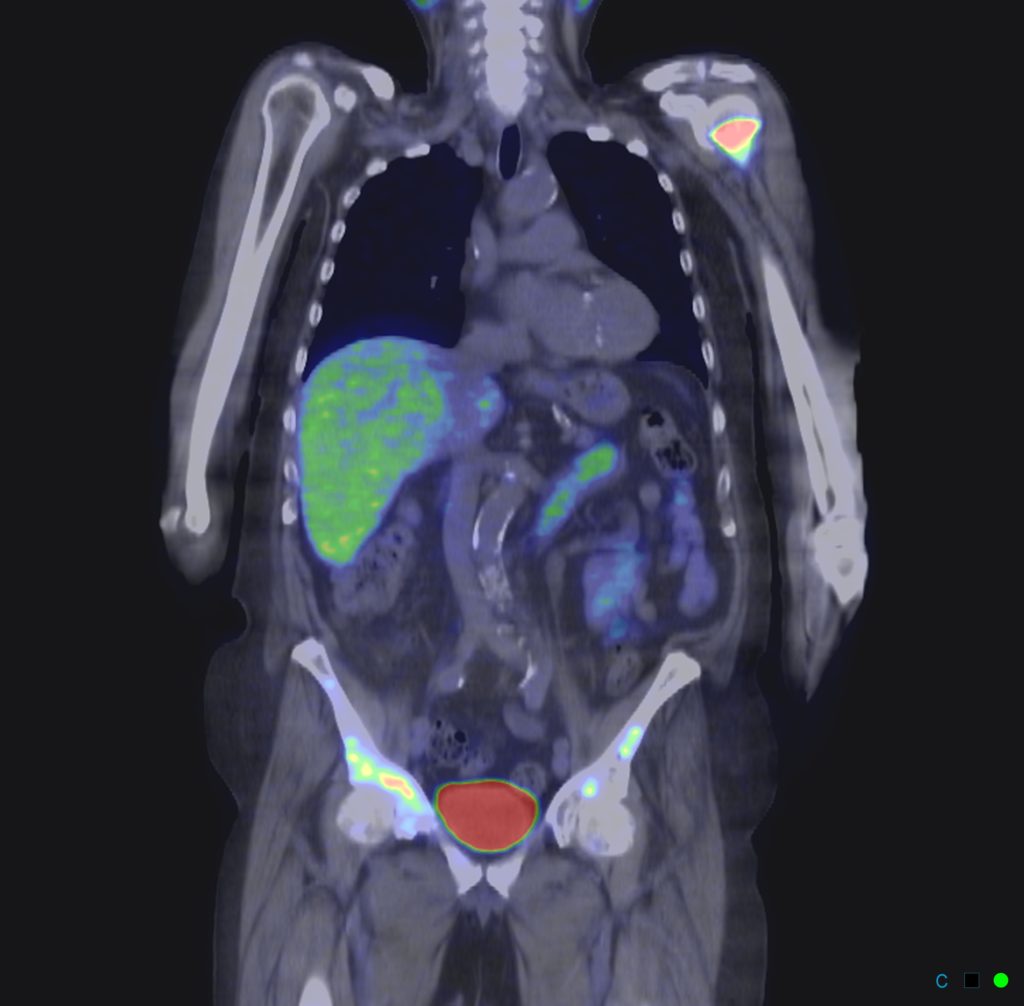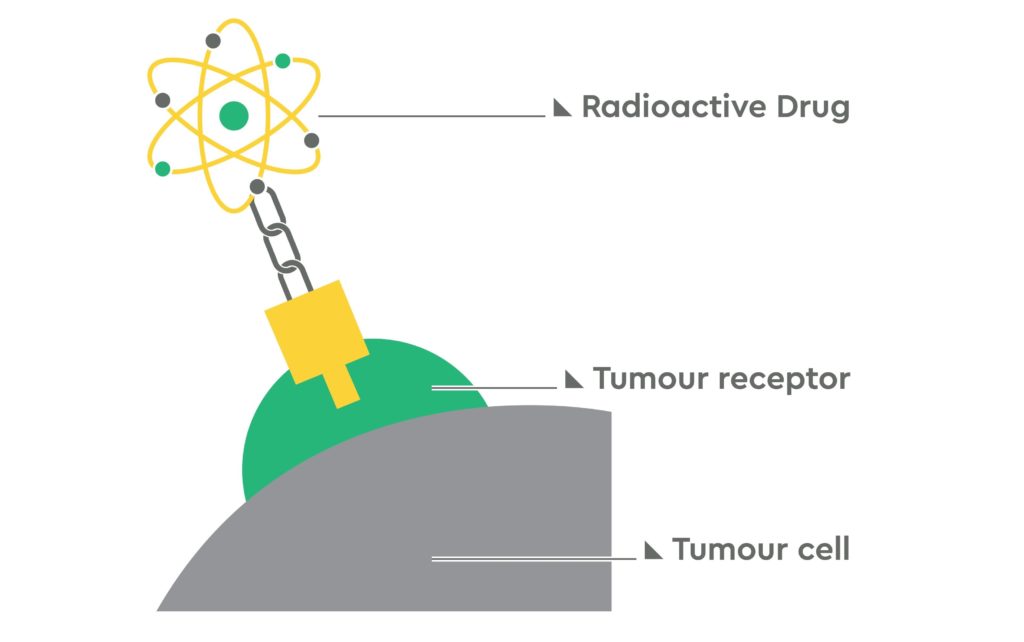Cancer remains one of the biggest causes of death in Australia. This year alone, an estimated 50,000 people nationwide will lose their lives to this complex and multifaceted disease – that’s about 140 of us each and every day.
Though the global and decades-long battle against cancer is seeing success, with increased survival rates in cancer patients overall, many forms of cancer remain incredibly difficult to treat.
We’re working hard to change that.
Through a new partnership with one of Australia’s largest cancer care providers and an emerging area of science called theranostics, we’re working to develop new therapies to fight even the most ‘untreatable’ cancers, and trial them right here in Australia.

A PET scan shows metastasised prostate cancer cells glowing in red in the shoulder and pelvis from the specially designed theranostic “homing missiles”. (Image: GenesisCare)
New treatments, faster
On the whole, cancer survival rates have improved, but people diagnosed with the most lethal forms of cancer — such as pancreatic and lung cancer — still have less than a one in five chance of surviving at least five years after their diagnosis. In fact, these types of cancers cause more than half of all cancer-related deaths.
Those who have metastatic cancer (where their cancer has spread to other parts of their bodies) face a similar distressing prognosis with very little available to them in terms of treatment.
Our new partnership with GenesisCare — one of the country’s largest cancer care providers — is powering the research we need to bring new, highly targeted therapies to patients suffering from some of the most fatal types of cancers including brain, pancreatic, ovarian cancer and metastatic cancers.
Our work with GenesisCare means that Australians will get access to any new therapies that are developed before the rest of the world because clinical trials will be based in Australia.
So, what sets theranostics apart from conventional cancer treatments?

The specially designed molecules, carrying a radioactive drug, seek out and attach themselves to unique cell signatures (‘tumour receptors’) on the surface of the cancer cells. The radioactive drug can then attack the cancer cell. (Image: GenesisCare)
Therapy + diagnostics = theranostics
Conventional cancer treatments today typically take a ‘one-size-fits-all’ approach; that is, patients receive the same treatment as others who have the same type and stage of cancer. But people can respond very differently to the same treatment, and its success varies.
That’s where theranostics comes in. Theranostics is a type of precision medicine which can be used to provide highly targeted cancer treatment, using molecular level diagnostics and therapy to find and attack individual cancer cells in a person’s body, leaving the neighbouring healthy cells alone. This is quite unlike systemic cancer treatments such as traditional chemotherapy, which can attack both cancerous and healthy cells, often causing debilitating side-effects for the patient.
Our scientists will be working to discover the unique signatures that are present for the cancer types we’re looking to treat, and then design special molecules to find and attach themselves to those cells. These molecules can then show us exactly where the cancer is located in the body, and deliver radiation directly to the cancer cells.
You can think of these molecules as ‘homing missiles’ that find and latch onto cancerous targets, allowing for highly targeted drug delivery.
You may not know it, but theranostics is already being trialled to better treat prostate and neuroendocrine cancers —with a rapidly developing body of evidence.

Specially designed molecules (‘targeting ligand’) seek out specific cancer cells. If they carry a diagnostic (1) they can show the exact location of the cancer cells in a scan, or if they carry a radioactive treatment (2) they can deliver the treatment straight to the cancer cell. (Image: GenesisCare)
The future of health monitoring and treatment
This new project is one of many we’re working on as part of our Probing Biosystems Future Science Platform: a multi-year, multi-disciplinary investment in our collective future, through devices and systems for real-time health and well-being monitoring.


24th July 2020 at 10:08 am
In September 2017 a scientist in a university in California invented a Ferrite Cancer Trap which he places under the patients skin either in the hand for blood born cancer cells or in the abdomen for lymph gland born cancer cells.
Every six months or so a surgeon opens up the wound and uses a magnet to attract the iron nanoparticles in the trap so as to remove it from the paitent, he then places a new cancer trap inside the wound and stiches it up.
The old cancer trap is sent away to pathology and is checked for cancer cells.
Eventually a pathology report comes back saying no cancer cells were found and the paitent is pronounced, cured.
See http://www.bbc.com/news/health-34191325
18th August 2019 at 3:11 pm
Hi, I am very intrested in your work. U r using small molecule or antibody in your wroks? Is it working in clinical trail? Will it target GI cancer and signet ring cells as well? look forward to your reply. Eric
19th August 2019 at 12:19 pm
Hi Eric,
Thanks for your message. Our researchers are aiming to design targeting ligands which specifically seek out unique signatures of the cells of specific cancers. The ligands then attach themselves to those cells and deliver a dose of radiation to those cells. Our project is hoping to be able to develop these molecules for various types of cancer. While our work is not yet at clinical trial stage, our partner GenesisCare has been involved in other trials using this technique for prostate cancer and neuroendocrine tumours. For more information on these trials please visit http://www.genesiscare.com/au/treatment/cancer/theranostics/ or contact them directly on theranosticsreception@genesiscare.com.au.
Thanks,
CSIRO social media team
10th June 2019 at 3:42 pm
Let’s start with out food chain a and look at the chemicals farmers are using
22nd May 2019 at 3:54 pm
“A PET scan shows metastasised prostate cancer cells glowing in red in the shoulder and pelvis from the specially designed theranostic “homing missiles”. (Image: GenesisCare)” Due to the posture of the patient (arms bent with hands on shoulders), it is not possible to know whether the “glowing in red” part that is attributed to the shoulder, isn’t actually from the hand instead. Of course, the “glowing in red” part is purely a colourisation of the PET scan, which only shows positron / electron annihilation intensity. None-the-less a great advance. I expect better targeting in the coming years.
21st May 2019 at 5:16 pm
Does this mean you will not be able to teat Lung cancer? I have heard that St John of Gods hospital have developed Laser treatment for Lung cancer.